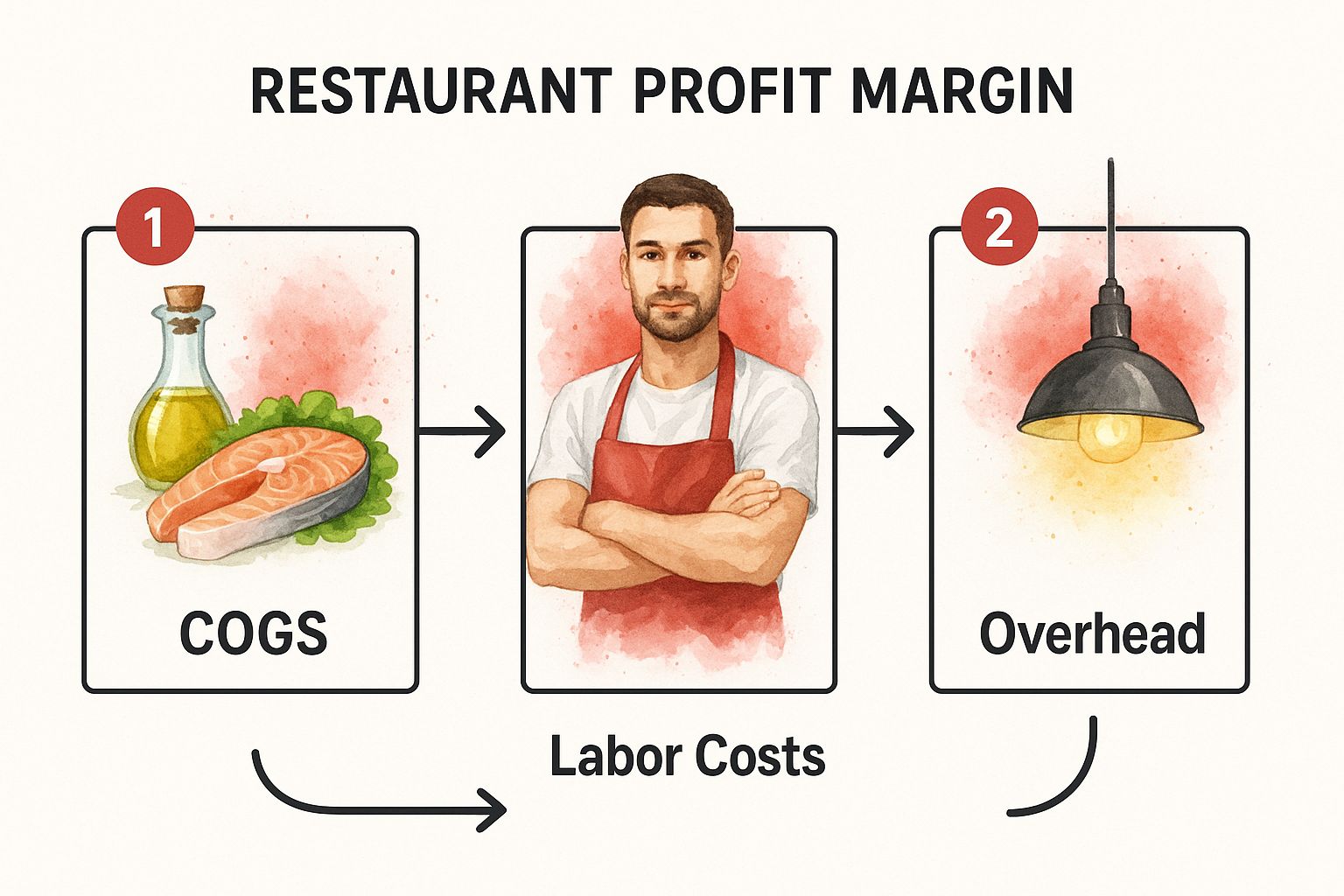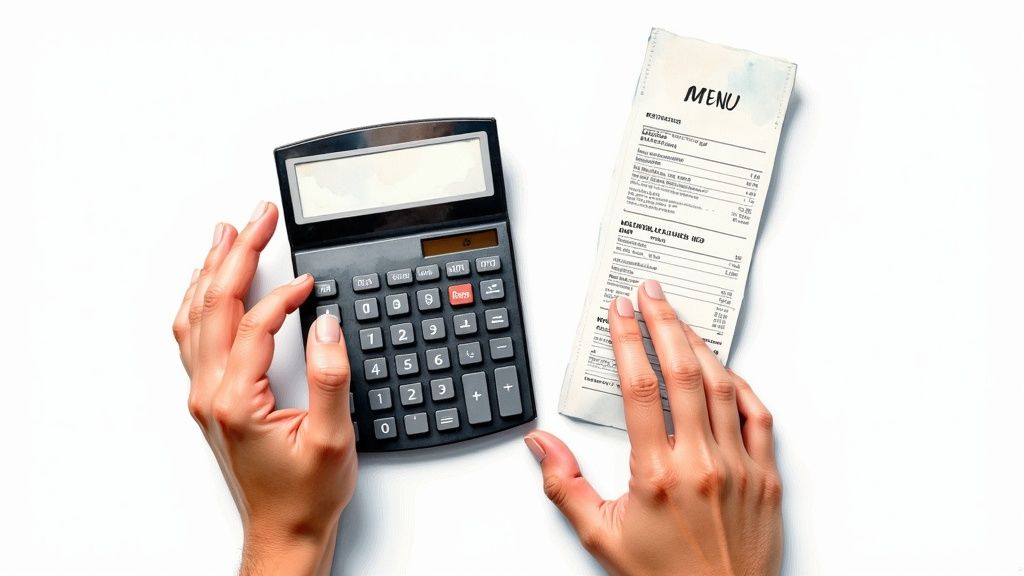How to use a restaurant profit margin calculator to make smarter financial decisions

A restaurant profit margin calculator is a simple mirror for your business. It takes your total sales, subtracts all your expenses, and shows you what percentage is pure profit. It’s the fastest way to get a real number on your restaurant's financial health.

Before plugging in numbers, it's critical to understand what profit margin means in the trenches. It’s not just an accounting term; it's your restaurant's pulse. This single percentage tells you if you're thriving, just surviving, or in trouble.
This number helps you answer the tough questions you face daily. Can you afford that new line cook? Is the Tuesday lunch special actually making money? Knowing your margin gives you the clarity to make these calls with confidence, not just hope.
There’s no single "good" number. Margins vary wildly by concept. A pizza joint has a different target than a high-end bistro juggling expensive proteins and a larger service team.
The average full-service restaurant profit margin is slim, usually between 3% and 5%. Fine dining might push that to 6% to 10% if they can command premium prices. You can explore more industry benchmarks on metrobi.com to see where you stack up.
The goal isn't just to hit an industry average. It's to understand your number so you can track it, protect it, and grow it. Your margin is a direct reflection of how well you manage your three biggest costs:
Here’s a quick reference for average profit margins to help you benchmark your performance.
These are just averages. Your numbers depend on your location, concept, and operations.
Any calculator is only as good as the numbers you put in it—garbage in, garbage out. You need to pull the right data for a specific period, usually the last month. To do that, you'll need two key figures: total revenue and total costs.
Total revenue is easy. It’s all the income your restaurant generated from sales. Your POS system should give you this number instantly. To see how the right system helps, check out our guide on how a restaurant POS system can transform your business operations.
This is where you'll find valuable insights. To manage costs, you must track expenses accurately, from every tomato to your utility bills.
Here’s a simple checklist:
Key Takeaway: Don't estimate. Use actual figures from your reports and invoices for a true picture of your restaurant’s performance.
Let's do the math. You just need your numbers and one simple formula. The formula for net profit margin is:
Net Profit Margin = [(Total Revenue - Total Costs) / Total Revenue] x 100
This calculation gives you the percentage of revenue left after every single bill has been paid. It’s the truest measure of your restaurant's financial health. For more detail, understanding how to find net operating income can give you an even clearer picture.
Let's use a realistic scenario for your numbers last month.
Now, plug those into the formula:
Your net profit margin is 10%. For every dollar that came in, you kept 10 cents as profit.

This breakdown shows how each expense category chips away at your revenue, leaving you with that final profit.

Net profit gives you the big picture. To fix what's broken, you need to zoom in on your gross profit margin. This number diagnoses the health of your menu, item by item. Net profit tells you if your restaurant is winning; gross profit tells you if each dish is scoring points.
This calculation is simpler. It ignores labor and overhead, focusing only on your food costs. The formula is:
(Total Revenue – Cost of Goods Sold) / Total Revenue x 100
Let's use our previous example: revenue was $50,000 and COGS was $15,000.
Your gross profit margin is 70%. For every dollar you bring in from sales, you have 70 cents left to cover labor, rent, and other costs. A healthy gross profit margin is around 70%, so this number indicates your menu pricing and food costs are in a good place.
A low gross profit margin is a red flag that your COGS are too high, your prices are too low, or both. It tells you exactly where to start digging to ensure every plate makes you money. Integrating your POS with platforms like Restaurant365 for financial management can automate these calculations, giving you real-time insights without living in a spreadsheet.
Calculating your profit margin is the easy part. The real work is turning that number into a plan that puts more money in your pocket. If your margin is thin, don't panic. It's time to make small, smart adjustments that add up.
Your first instinct might be to raise prices across the board, but that can backfire. Instead, think surgically. A $0.50 increase on your top five best-sellers might be barely noticeable to guests but could add thousands to your bottom line over a year.
On the cost side, food and labor are your biggest opportunities. Don't just accept supplier pricing. Pick up the phone and ask for better terms. Even a 2-3% discount from your produce vendor makes a real difference.
Pro Tip: Look at your staff schedule for the slowest two hours of your slowest day. Are you overstaffed? Cutting one person's shift during those quiet periods can save hundreds in labor costs each month without impacting service during the rush.
Keep an eye on the bigger picture, too. Economic pressures and guest habits are always changing. Staying on top of industry shifts is crucial for protecting your margin. You can discover more insights on 2025 restaurant trends from Squareup.com.
Here are a few actions you can take this week:
Let's clear up a few common questions restaurant owners have about their financials.
At a minimum, run these numbers monthly. This helps you react quickly to rising costs or slow sales. The most successful operators do a weekly check-in on their prime cost (food and labor combined). This is the best way to catch problems early.
Mixing these up is a costly mistake.
Markup is what you add to your cost to get a selling price. If a steak costs you $8 and you sell it for $32, your markup is $24.
Profit margin is the percentage of the final price that is profit. In that same example, your margin is 75% ($24 profit / $32 selling price). Margin gives a truer picture of your financial health.
You can explore more benchmarks in our restaurant profit margin guide.
If your margin is thin, start with your prime cost: the total of your food (COGS) and labor costs. Together, they are your biggest expenses and have the most opportunity for quick improvement. Audit your food waste, portion control, supplier pricing, and staff schedules. Small changes here make the biggest impact.
Ready to stop guessing and start knowing your numbers? Peppr gives you the real-time data you need to calculate your profit margin accurately and make smarter decisions. See how you can take control of your restaurant's finances.
A restaurant profit margin calculator is a simple mirror for your business. It takes your total sales, subtracts all your expenses, and shows you what percentage is pure profit. It’s the fastest way to get a real number on your restaurant's financial health.

Before plugging in numbers, it's critical to understand what profit margin means in the trenches. It’s not just an accounting term; it's your restaurant's pulse. This single percentage tells you if you're thriving, just surviving, or in trouble.
This number helps you answer the tough questions you face daily. Can you afford that new line cook? Is the Tuesday lunch special actually making money? Knowing your margin gives you the clarity to make these calls with confidence, not just hope.
There’s no single "good" number. Margins vary wildly by concept. A pizza joint has a different target than a high-end bistro juggling expensive proteins and a larger service team.
The average full-service restaurant profit margin is slim, usually between 3% and 5%. Fine dining might push that to 6% to 10% if they can command premium prices. You can explore more industry benchmarks on metrobi.com to see where you stack up.
The goal isn't just to hit an industry average. It's to understand your number so you can track it, protect it, and grow it. Your margin is a direct reflection of how well you manage your three biggest costs:
Here’s a quick reference for average profit margins to help you benchmark your performance.
These are just averages. Your numbers depend on your location, concept, and operations.
Any calculator is only as good as the numbers you put in it—garbage in, garbage out. You need to pull the right data for a specific period, usually the last month. To do that, you'll need two key figures: total revenue and total costs.
Total revenue is easy. It’s all the income your restaurant generated from sales. Your POS system should give you this number instantly. To see how the right system helps, check out our guide on how a restaurant POS system can transform your business operations.
This is where you'll find valuable insights. To manage costs, you must track expenses accurately, from every tomato to your utility bills.
Here’s a simple checklist:
Key Takeaway: Don't estimate. Use actual figures from your reports and invoices for a true picture of your restaurant’s performance.
Let's do the math. You just need your numbers and one simple formula. The formula for net profit margin is:
Net Profit Margin = [(Total Revenue - Total Costs) / Total Revenue] x 100
This calculation gives you the percentage of revenue left after every single bill has been paid. It’s the truest measure of your restaurant's financial health. For more detail, understanding how to find net operating income can give you an even clearer picture.
Let's use a realistic scenario for your numbers last month.
Now, plug those into the formula:
Your net profit margin is 10%. For every dollar that came in, you kept 10 cents as profit.

This breakdown shows how each expense category chips away at your revenue, leaving you with that final profit.

Net profit gives you the big picture. To fix what's broken, you need to zoom in on your gross profit margin. This number diagnoses the health of your menu, item by item. Net profit tells you if your restaurant is winning; gross profit tells you if each dish is scoring points.
This calculation is simpler. It ignores labor and overhead, focusing only on your food costs. The formula is:
(Total Revenue – Cost of Goods Sold) / Total Revenue x 100
Let's use our previous example: revenue was $50,000 and COGS was $15,000.
Your gross profit margin is 70%. For every dollar you bring in from sales, you have 70 cents left to cover labor, rent, and other costs. A healthy gross profit margin is around 70%, so this number indicates your menu pricing and food costs are in a good place.
A low gross profit margin is a red flag that your COGS are too high, your prices are too low, or both. It tells you exactly where to start digging to ensure every plate makes you money. Integrating your POS with platforms like Restaurant365 for financial management can automate these calculations, giving you real-time insights without living in a spreadsheet.
Calculating your profit margin is the easy part. The real work is turning that number into a plan that puts more money in your pocket. If your margin is thin, don't panic. It's time to make small, smart adjustments that add up.
Your first instinct might be to raise prices across the board, but that can backfire. Instead, think surgically. A $0.50 increase on your top five best-sellers might be barely noticeable to guests but could add thousands to your bottom line over a year.
On the cost side, food and labor are your biggest opportunities. Don't just accept supplier pricing. Pick up the phone and ask for better terms. Even a 2-3% discount from your produce vendor makes a real difference.
Pro Tip: Look at your staff schedule for the slowest two hours of your slowest day. Are you overstaffed? Cutting one person's shift during those quiet periods can save hundreds in labor costs each month without impacting service during the rush.
Keep an eye on the bigger picture, too. Economic pressures and guest habits are always changing. Staying on top of industry shifts is crucial for protecting your margin. You can discover more insights on 2025 restaurant trends from Squareup.com.
Here are a few actions you can take this week:
Let's clear up a few common questions restaurant owners have about their financials.
At a minimum, run these numbers monthly. This helps you react quickly to rising costs or slow sales. The most successful operators do a weekly check-in on their prime cost (food and labor combined). This is the best way to catch problems early.
Mixing these up is a costly mistake.
Markup is what you add to your cost to get a selling price. If a steak costs you $8 and you sell it for $32, your markup is $24.
Profit margin is the percentage of the final price that is profit. In that same example, your margin is 75% ($24 profit / $32 selling price). Margin gives a truer picture of your financial health.
You can explore more benchmarks in our restaurant profit margin guide.
If your margin is thin, start with your prime cost: the total of your food (COGS) and labor costs. Together, they are your biggest expenses and have the most opportunity for quick improvement. Audit your food waste, portion control, supplier pricing, and staff schedules. Small changes here make the biggest impact.
Ready to stop guessing and start knowing your numbers? Peppr gives you the real-time data you need to calculate your profit margin accurately and make smarter decisions. See how you can take control of your restaurant's finances.
